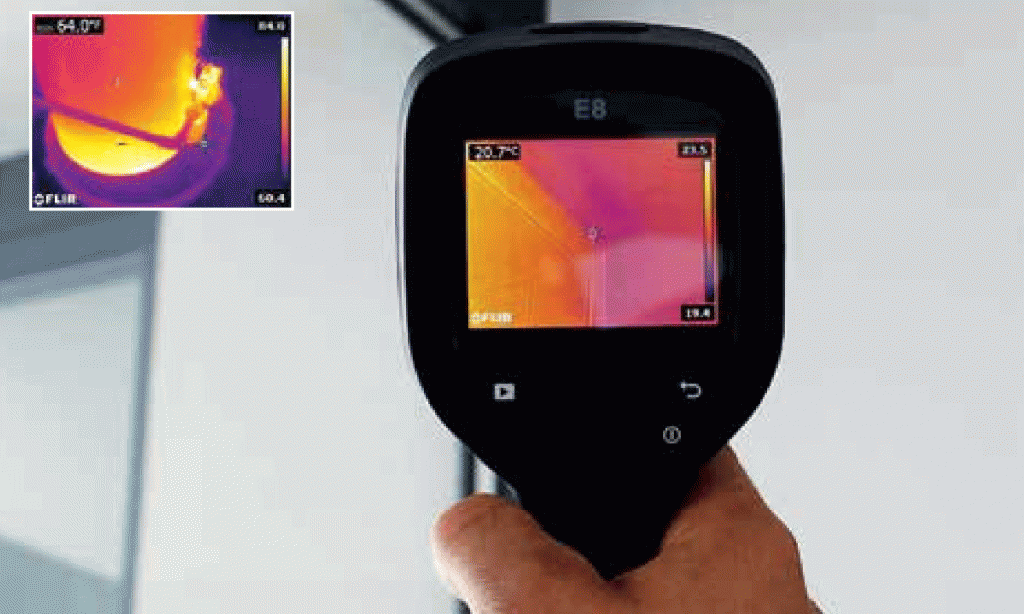Inspecting buildings using a thermal imaging camera is a powerful and non-invasive means of monitoring and diagnosing the condition of buildings. A thermal imaging camera can identify problems early, allowing them to be documented and corrected before becoming more serious and more costly to repair. A thermal image that includes accurate temperature data provides building experts with important information about the insulation conditions, moisture ingress, mould development, electrical faults, the presence of thermal bridges and the conditions of HVAC systems.
Heating, Ventilation and Air-Conditioning (HVAC) systems need to be well maintained. They need to deliver air at the correct humidity and temperature and filter any indoor pollutants. Thermal imaging can help to determine whether HVAC systems are operating properly. When working incorrectly they can cause poor indoor air quality.
* Case study: Swedish hospital maintains HVAC system with thermal imaging
In hospitals, climate control is of critical importance, to ensure both hygiene and comfort for the patients and personnel. That is why the technical staff of a Swedish hospital have acquired a FLIR thermal imaging camera to inspect and maintain its HVAC system. The FLIR thermal imaging camera is an ideal tool for this, but it also has use in other areas such as building insulation inspections and electrical maintenance inspections.
“The camera provides us with the right information and allows us to make informed decisions with regard to maintenance of the HVAC system and troubleshooting all kinds of building issues,” says one of the hospital technicians. “The air temperature in the hospital should be 22°C and the air coming from ventilation ducts should be 18°C. There are thermometers installed in certain parts of the building and these provide feedback for the automated HVAC system we use. This gives us a general overview, but if we want more specific information about the airflows and temperature distribution in a room we need the FLIR thermal imaging camera.”
Some hospital rooms require even more detailed monitoring, with the operation room a prime example. “For different types of operations, different ambient temperatures are necessary. And a close control of air circulation is an obvious necessity to prevent contamination with airborne pathogens. We therefore regularly check and closely monitor the HVAC systems of the operation rooms with the FLIR thermal imaging camera.”
Faults that the two technicians sometimes find in the hospital’s HVAC system are clogged radiators and blocked ventilation ducts. “But there is much more we can do with the camera, such as inspecting fuse cabinets and mechanical components in the ventilation system for faults, checking whether the district heating shunt group is cooling the warm water down to the right temperature and even the backup batteries in the server room.”
* Thermal imaging Vs spot pyrometers
According to the hospital’s technicians, the camera has been a great addition to their assortment of tools. “Before we had this thermal imaging camera, we had to base our maintenance inspections on contact measurements.
“We had to either touch warm components manually or use a spot pyrometer. In our experience none of these methods are as quick, effective and accurate as a thermal imaging camera.”
Thermal imaging cameras have important advantages compared to spot pyrometers. “The spot meter just gives you a value of a small area. Using it for inspections is very labour intensive and it lacks the overview that a thermal imaging camera gives. On a thermal image you can immediately scan an entire area for thermal hot or cold spots and see at once where the problem is located.”
The details may vary, but a spot pyrometer is basically similar to a thermal imaging camera with one pixel, as it tells you the temperature of one spot. A FLIR thermal imaging camera provides the same accurate temperature readings, but it gives you not one, but thousands of temperature readings at the same time. With a spot pyrometer it is very easy to miss crucial information.
“The spot pyrometer gives you a number. The thermal imaging camera presents an image of the entire area – this makes a huge difference. You can immediately see the temperature distribution in the entire area and quickly spot problems that would otherwise remain undetected.”
* About FLIR
FLIR Systems, Inc. designs, develops, manufactures, markets and distributes technologies that enhance perception and awareness. It brings innovative sensing solutions into daily life through thermal imaging systems, visible-light imaging systems, locator systems, measurement and diagnostic systems and advanced threat detection systems. Its products improve the way people interact with the world around them, enhance public safety and well-being, increase energy efficiency and enable healthy and entertained communities. Pioneers in thermal imaging, the company was founded in 1978, originally providing infrared imaging systems that were installed on vehicles for use in conducting energy audits. Today its advanced systems and components are used for a wide variety of thermal imaging, situational awareness and security applications.
Its products are available via distributors in the UAE, Qatar, Saudi Arabia, Oman, Bahrain and Kuwait.
For more information, go to www.flir.co.uk

